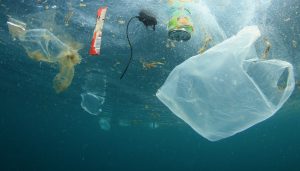Ocean plastic pollution is a deeper problem, not just a surface issue, study says
Devices that clean up plastic pollution from the ocean surface are not effective enough to solve the broader issue, researchers have said.
The Great Pacific garbage patch – a floating collection of plastic waste that has accumulated on the surface of the ocean – is estimated to hold around 1.8 trillion pieces of plastic and weigh around 87,000 metric tons in total.
However, estimates suggest that the plastic debris floating on the ocean surface accounts for only 5 per cent of all the plastic trash dumped into the sea; the remaining 95 per cent is submerged beneath the surface.
University of Exeter researchers compared estimates of current and future plastic waste with the ability of floating clean-up devices to collect it and found the impact of such devices was “very modest”.
They found that river barriers could be more effective: while having no impact on the plastic already in the oceans, they could reduce future pollution “significantly” if used in tandem with surface clean-up technology.
The authors of the study estimate that the amount of plastic reaching the ocean will peak in 2029, with surface plastic reaching over 860,000 metric tonnes – more than double the current estimated amount of 399,000 tonnes – by 2052. Previous research had suggested the rate of plastic pollution may finally reach zero.
“The important message of this paper is that we can’t keep polluting the oceans and hoping that technology will tidy up the mess,” said researcher Dr Jesse F. Abrams.
“Even if we could collect all the plastic in the oceans – which we can’t – it’s really difficult to recycle, especially if plastic fragments have floated for a long time and been degraded or bio-fouled.
“The other major solutions are to bury or burn it, but burying could contaminate the ground and burning leads to extra CO2 emissions to the atmosphere.”
Private initiatives proposing to collect plastic from oceans and rivers have gained widespread attention recently. One such scheme, the Ocean Cleanup, aims to clean the Pacific garbage patch over the next 20 years using 600m-long floating barriers to collect plastic for recycling or incineration on land.
The new study analysed the impact of deploying 200 such devices, running without downtime for 130 years from 2020 to 2150. In this scenario, floating plastic debris would be reduced by 44,900 metric tonnes – just over 5 per cent of the estimated global total by the end of that period.
“The projected impact of both single and multiple clean-up devices is very modest compared to the amount of plastic that is constantly entering the ocean,” said Dr Sönke Hohn of the Leibniz Centre for Tropical Marine Research, which collaborated on the project. “These devices are also relatively expensive to make and maintain per unit of plastic removed.”
As most plastic enters the oceans via rivers, the authors say a “complete halt” of such pollution entering the ocean using river barriers – especially in key polluting rivers – could prevent most of the pollution they predict will happen otherwise over the next three decades.
Read the full and original story at eandt.theiet.org



